I’m not much of a driver. I wasn’t one of those people who rushed out to get my drivers license as soon as I possibly could. To be honest I prefer walking or cycling, failing that I will use the train if I am going into the city. City driving frustrates me, far too many bad drivers, one-way street systems and red lights to allow it to be an enjoyable experience. Motorways just bore me. That said if I want to escape the stress of work for a few hours then there is one type of driving that I enjoy. Those would be Scottish country roads, particularly those less travelled. I particularly like driving on single-track roads of which there are many in Scotland, hidden away off the beaten track. Before I go on perhaps I should explain what single tracks roads are just in case someone who reads this isn’t familiar with them. Single-tracks are roads which have only one lane used by vehicles going in both directions and tend to be found in remote areas, where it is either impractical to go to the expense of building two lanes or where the terrain does not permit the construction of two lanes. The trick to single-track roads is to drive with a combination of consideration and assertiveness. In an ideal world, drivers should adjust their speeds so as to meet at a passing place. That way neither waits for the other, and both proceed at best speed. Not everyone has the common sense to see the logic in such behaviour but I’ll write about that in another post.
Single-track road in Glen Lyon
Anyway now that I’ve explained that back to what I was saying, in order to get a true flavour of great Scottish driving I would suggest that you have to experience at least one single-track road. I have a few favourites that I like to visit on a regular basis. Some near Glen Coe just for the majesty of the Highland Mountains that really are awe inspiring, and then closer to home there is the road to Loch Katrine that never fails to appeal no matter what the season.
Today I just needed to get away from it all, it had been a long hard week and the rain hadn’t made it any easier so I headed out to Perthshire. I deliberately stayed away from the open roads and stuck to the wooded roads, before long I found myself in Crieff which is where I would have liked to have begun this drive. Driving past Drummond Gardens, which is well worth a visit in itself, I headed on through Crieff sticking to the A822 into Glen Quaich at Amulree before eventually reaching Glen Lyon and Ben Lawer.
This particular route took me along some of the most dramatic small roads in central Scotland, predominantly single-track. The kind of driving demanded by single-track roads suit my psyche superbly. Normally I do everything at a 100 mph, I work hard, I work fast, I do it right first time otherwise it just pisses me off, but when I want to get away from it all I like to take in the scenery and forget about work. Therefore I enjoy driving on roads like this, roads that encourage me to move forward carefully, with regard to others at all times, it just helps to clear my mind. Theres no room for road rage, there's no point. In roads such as this you must stop from time to time and take stock, just admire the view, take in the wildlife, allow others to pass and proceed at haste only when you can see your way is clear ahead.
This road takes you quickly into a hidden valley. There are frequent blind summits and two entertaining humpback bridges (the first in particular can be quite startling). The land at times seems almost hostile, a feeling added to by the sight of ruined dwellings long since deserted by crofters forced from the land. The dreaded hairpins appear in the distance, a slow and low-gear approach gets you round in one piece. You climb towards the rounded tops of hills, scoured by glacial erosion into volcanic-shaped craters and rock-strewn lunar landscapes and finally reach a plateau where, as you can pause in the layby, you find acres and acres of silence.
The road soon moves abruptly downhill and the small town of Kenmore, a veritable city after the bleakness of the past 10 miles, sweeps into view on the far side of the shimmering Loch Tay. Here you can visit the Crannog, a reproduction of a 2600-year-old dwelling constructed using information collected during underwater archaeological surveys the pure loch water having preserved things so completely that even traces of butter on a dish have been identified. Nobody is entirely sure of why these crannogs were built on the water to protect from the numerous wild animals perhaps, to enable heavy goods to be transported by canoe, or maybe just to evade the midges which hover close to the shoreline and for some reason won't venture the few feet across the bridge. On this occasion rather than pick the knowledge of the locals I decided to drive on.
Fortingall
Next stop on the route is the charming village of Fortingall, a few minutes north of Kenmore. Here the architectural styles jump forward a couple of thousand years to the arts and crafts movement of the late 1800s (though, curiously, the roofs are also thatched). The sight of this cluster of exquisite thatched cottages is quite startling in this Highland setting. Driving slowly past the buildings it is easy to spot the arts and crafts motifs that appear in later work by Charles Rennie Mackintosh (whose work you’d find in Glasgow): the small square windows, the creation of patterns using straight lines and organic floral details. The inhabitants are clearly proud of this architectural heritage and have preserved the houses superbly. My favourite detail is to be found on the gateposts. Rather than ostentatious lions, each post displays a pile of flat stones gathered from the river.
At the far end of the village, next to the church, is the thing that most people associate with this part of the world the ancient yew tree. It is thought to be 5000 years old and the oldest living thing in Europe and perhaps the world. This mighty tree was recorded in 1771 by traveller and naturalist Thomas Pennant as having a girth of 56 1/2ft. Sadly the original massive trunk has been destroyed to a third of its size, probably by memento hunters and local Beltane fire-starters but the mighty yew is still an inspiring sight. Perhaps because of this tree, the location has been a site of sacred ritual for at least 2000 years.
On the hill behind this the Romans built a fort. It is rumoured that Pontius Pilate was born here but such a claim seems a bit extreme when you consider this area would have been at the very edge of the Roman empire and the dates of which they were here and Pontius was born are not certain to match up. The Romans withdrew from the fort and retired further south after just a few decades deciding that the local tribes were too troublesome for any apparent gain in the land. Nonetheless you can tell the historical importance of this area just by looking at the gravestones, some of them date back to about the fourth century. One of the gravestones has a Templar Knights cross on it (maybe someone should tell Dan Brown to help him with his next conspiracy book) while another is made from a Celtic standing stone, highly unusual for a Christian burial ground. Anyway I moved on when a coachload arrived to snap yet more pictures of the old tree.
Next Glen Lyon beckoned. The start of the glen is a sunny birch tunnel close to the Birks of Aberfeldy, and the sight of white-silver bark struck by the early afternoon sun is wondrous. The glen snakes westwards and reveals the mountains beyond in Scotland's longest and possibly loneliest glen. Once through Invervar you come to the thriving Bridge of Balgie post office and tea room. I could have been forgiven for believing I had stumbled on a birthday party here in the middle of nowhere as it was busy with walkers, drivers, birdwatchers and, presumably, the odd person posting a letter. Apparently it is always as busy as this in summer, as it is the last possible place to buy refreshments at least for a few lonely miles, but this was November so I’ll be damned if I could explain why it was still busy this late in the year.
Birks of Aberfeldy
At this point, I left the glen road to head to my final destination: Ben Lawers. This final stretch of road feels as though it could be in the furthest reaches of the Highlands. Yet here you are only a few minutes' drive from commuterland. The magnificent 4000ft or so giant that must be tackled towers ahead. From the excellent Ben Lawers visitor centre a short nature walk of about 20 minutes has been waymarked. This place has an extraordinary array of wildlife and wild habitats and the plan is to keep it that way. I took in both the nature walk and the walk to the summit of Ben Lawer in less than a couple of hours. After taking my time getting here I was back to my usual 100 mph walking speed. I can't help but walk fast, but damn was I breathing hard by the time I got to the top. The problem is from the car park what appears to be peak of Ben Lawers looks very manageable. The only trouble being is that it isn't the peak at all. Once you get to that ridge you discover theres another, and then another one beyond that and then yet another. By the time you get to the top of the mountain you've expended more energy than you had initially expected, and doing it as fast as I did isn't advisable.
However enough of my bitching if you ever get the pleasure of taking this drive and walk I would encourage you to sit in the warmth of the sun in the long reedy grass drinking in the view below before returning to the car park, but that might mean going in summer, today though nice was a little on the cold side. Anyway from there you can watch as the sunlight flickers on the surface of the mighty Loch Tay. If you are lucky to have a day like today the sky will be pure blue allowing the daylight to dance on the summits of Ben More and the Tarmachan Ridge.
Loch Tay






1 comment:
hello :)
you have such nice photos!!!
if you like pics, i guess you do, please check out my blog http://tathims.blogspot.com when you have time... have a great week!
Post a Comment